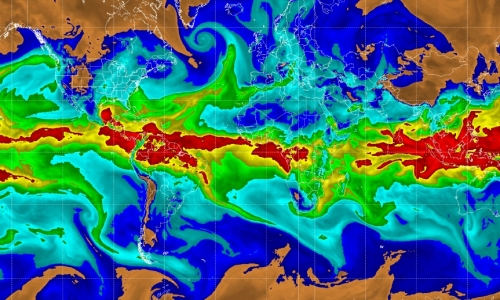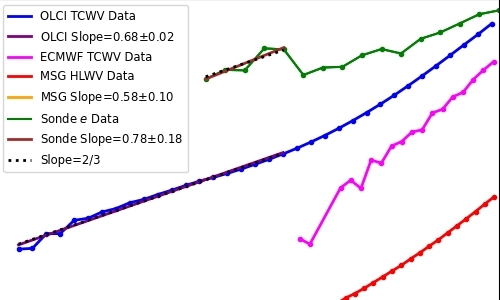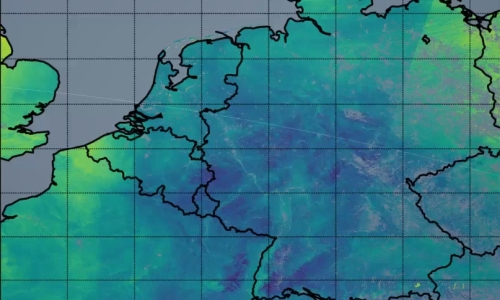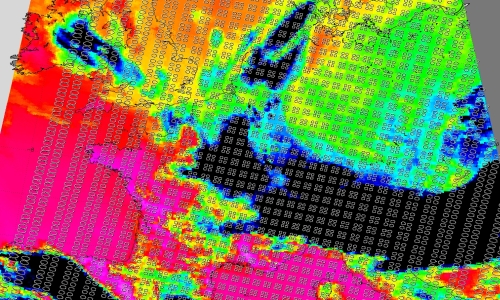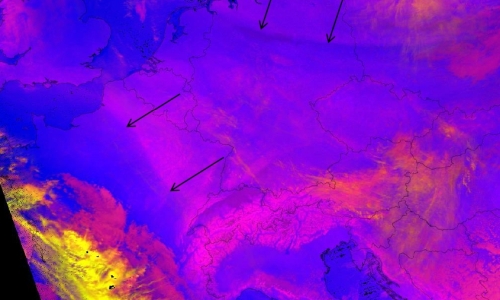Identify and interpret fields and derived products
Sheldon J. Kusselson (CIRA) shows us the Advected Layered Precipitable Water (ALPW) and Total Precipitable Water (TPW) products and how to apply them for forecasting hazardous events.
Water vapor availability is a key factor in forecasting heavy precipitation. Passive microwave instruments onboard several polar orbiting spacecraft measure emission from water vapor and provide a capability to sense layers of and total water vapor in the atmosphere. Via fusion of passive microwave retrievals from five or more polar orbiting spacecraft and model wind fields, the Advected Layered Precipitable Water (ALPW) and Total Precipitable Water (TPW) products are created hourly. The new ALPW product and upgraded Total Precipitable Water products, including a percent of normal TPW product, will become operational for forecasters in 2023. In the meantime, CIRA already produces the products hourly on the internet. During the past decade applications for the ALPW and TPW products have been developed for many different types of weather events, with a focus on heavy precipitation. This presentation will highlight applications for various weather hazards such as heavy rain causing flooding and heavy snow. Case studies using applications for the ALPW and TPW products in different parts of the world, including Europe, will be presented.
Xavier Calbet (AEMET) presents his work on water vapour variability in the atmosphere and the effect of the variability on the water vapour fields in its vicinity.
Water vapor at small scales (< 6 km) behaves, on average, in an stochastic way. This behavior can be described by simple stochastic models (Gaussian Random Fields). Knowing the variability (or turbulence) of water vapor in a location, mainly via measurements, we can infer the statistical characteristics of water vapor fields in its vicinity. This model will help us in: determining whether water vapor measurements from satellites can be more or less biased, integrate different water vapor measurements coming from differing spatial scales together in a coherent way, estimate the turbulence that is potentially present in the atmosphere. Direct consequences of this concept regarding Nowcasting still need to be explored in the future.
Jan El-Kassar and Cintia Carbajal Henkel (Free University of Berlin) talk about their efforts to develop an optimal estimation algorithm for the 0.865 and 0.914 micrometer bands to retrieve a total column water product.
MTG-FCI will feature a band configuration in the rho-sigma-tau absorption band of water vapour (0.865 and 0.914 microns). We are developing an optimal estimation algorithm for these two bands to retrieve a total column water vapour product, which will be highly sensitive to boundary layer moisture.
We show preliminary results from a first prototype based on COWa (Copernicus Sentinel-3 OLCI Water Vapour) applied to spatially high-resolved data (~300m) from the Ocean and Land Colour Imager (OLCI) onboard the polar-orbiting satellites Sentinel-3.
In a next step we analyse the relationship between spatial variability metrics in the water vapour field and convective initiation over Germany, exploiting the advanced observation capabilities of current and future satellite-based imagers.
Thomas August (EUMETSAT) presents the current polar satellite sounders and makes a comparison with the capabilities of the future MTG infrared sounder
Satellite infrared sounders like IASI allow retrieving the vertical structure of the atmospheric humidity. Their measurements are exploited in synergy with the microwave (MW) sounders, when such companions are present on the same platforms as is the case in the operational EUMETSAT Polar System (EPS) programme and in the EPS-Second Generation (SG). This synergy increases the yield and quality of sounding in cloudy pixels. The future infrared sounder (IRS) onboard Meteosat Third Generation (MTG) will operate without MW companions. It will however provide unprecedented spatio-temporal sounding, with a typical ground-resolution of 7km and observations every 30 minutes over Europe.
The extensive utilisation of machine learning guarantees the provision of reliable atmospheric temperature and humidity profiles and uncertainty estimated within less than 30 minutes from sensing. We present here the characteristics of satellite thermodynamic profiles from the current and future missions and the experience made in studies with meteorological services to contribute to nowcasting severe weather events, and prepare to the future sounder missions.
Hans Peter Roesli showcases the usefulness and characteristics of the 0.9 micrometer band channels, one of which will be available with MTG satellites.
At the time of refining the FCI requirements for nowcasting applications, numerical forecasts had much difficulty in handling low-level humidity (low-level forecasts rapidly dried with increasing forecast time). This was one of the reasons why the expert team for nowcasting proposed to add in MTG’s FCI.a solar water-vapour-absorbing in the 0.9-micron region (now NIR 0.914 micron) alongside the clear NIR 0.865 micron band. Although nowadays operational numerical models have overcome the moisture problem, NIR 0.914 might still find valuable applications, in particular when accounting for the frequent imaging of the same scene in daylight.
MODIS includes a clear NIR 0.8585 band and 3 bands in the 0.9-micron region: 0.936, 0.940 and 0.905 micron, with decreasing water vapour absorption. Selecting NIR 0.8585 and the weakest absorbing NIR0.905 as proxy bands for FCI some meteorological situations were investigated, where low-level humidity monitoring could have been beneficial to nowcasts. MODIS flying on Terra and Aqua usually deliver two daylight overflights of the same scene, which allows for a rough appreciation of evolution in time.
Gao&Kaufman (2003) discussed the MODIS bands in view of the MOD05/MYD05 products for Total Precipitable Water Vapour. Based on their paper MODIS imagery of the reflectivity ratio 0.905/0.8585 was produced as a proxy for FCI. Taking the ratio is simple and damps further the (minor) differences in background reflectivity between the two bands. It was found that the ratio generally varies between 0.6 (humid boundary layer) and (dry boundary layer), as already given by Gao&Kaufman.
Examples under clear European skies will show situations of old frontal zones, convergence lines or north foehn. A more complex situation of low-level moisture advection under cloudy skies over the Po Valley affords the frequent FCI imaging, in order to get the full picture of the moist-air advection.
The purpose of the lecture is to provide a necessarily brief overview of the basic physical principles underlying satellite precipitation estimation methods.
The estimation of precipitation from space was attempted almost at the beginning of the satellite meteorology era by establishing a somewhat loose link between visible and infrared imagery of cloud tops and precipitation intensity at the ground. Since the early days estimation methods have qualitatively and quantitatively evolved with the advent of passive microwave sensors first and precipitation and cloud radars more recently. The purpose of the lecture is to provide a necessarily brief overview of the basic physical principles underlying satellite precipitation estimation methods trying to make the audience aware of what the sensors actually “measure” (radiation properties) and how these measurements are converted into precipitation intensity. All the methods, either based on “passive” or “active” sensing, are necessarily indirect and thus a clear understanding of the physics of radiation and of cloud hydrometeors is needed for the correct use of the products. In fact, such understanding helps in identifying the limitations of the existing precipitation products, which are too often used improperly or taken for granted. The lecture will try to pave the way to the in depth lectures of the other instructors on more specific topics of the discipline.
Jason Apke presents a method to derive winds from satellite data and shows some example applications.
The new Geostationary Operational Environmental Satellite (GOES)-R Series Advanced Baseline Imager and similar instruments represent a substantial improvement in the spatial, spectral, temporal, and radiometric resolution of operational space-based imagery for atmospheric sciences. The enhanced resolutions enable the objective derivation of fine-scale brightness motion, or so-called "optical flow" (OF), over a variety of meteorological phenomena with techniques that address the weaknesses of current generation cloud and feature tracking algorithms. The techniques even allow for precise dense OF derivation, or motion retrieval at every image pixel, which has a variety of applications that will be invaluable to satellite remote sensing-based forecasting and research in the future. These applications include Atmospheric Motion Vector fields, temporal brightness interpolation, feature extrapolation, image stereoscopy, and semi-Lagrangian brightness temperature field derivation. As motion is an observable that provides unique context on features observed with an image, OF fields further offer significant new predictors to a variety of objective machine learning and decision-making tools now in development. This presentation will go into detail on how some of these new dense OF techniques are derived and highlight efforts to produce and validate new products. Demonstrations of novel RGBs and their uses for operational forecasting will be overviewed, such as blends of derived speed for inferring shear and cloud-top cooling for inferring vertical growth with clouds in visible satellite imagery. Efforts to validate wind products will also be shown which highlight the strengths and weaknesses of dense OF derivation for satellite remote sensing purposes. Examples of future applications and research will also be covered, including a look into the future of OF derivation with an example 6-sec GOES-17 dataset.
Mary Forsythe presents the impact of satellite winds on the performance of NWP models (ECMWF).
Satellite-derived winds are an important part of the global observing system. Atmospheric motion vectors, derived from tracking clouds in satellite imagery, and ocean surface winds from scatterometers have been routinely assimilated in global and regional NWP models for many years. More recently, wind profiles have become available from the Aeolus Doppler Wind Lidar. The talk will focus on how we use these datasets, their impact in global NWP models and some thoughts for the future.
Ad Stöffelen provides an overview on current wind products and services.
Never before so many ocean wind sensing satellites were available for application in meteorology, oceanography and climate. These satellite ocean winds are continually improved in quality and service. An overview will be provided of the current products and services, with particular focus on their earth coverage, timeliness, quality and on coastal and extreme winds. Furthermore, relevant aspects for application in nowcasting, ocean forcing, climate and NWP data assimilation will be highlighted.
Anu-Maija Sundström gives an overview presentation on AC SAF products and on long-range transport events.
AC SAF provides various satellite observations on atmospheric composition, that are relevant for assessing air quality and climate. In this talk an overview of the AC SAF products is given by introducing practical examples of recent major air quality episodes. The focus will be on long range transport events that are highly affected by prevailing wind conditions.
Régis Borde gives an overview on the actual wind products extracted from polar satellites over the world.
Derivation of wind products from polar orbiting satellites has been developed in the 2000’s to populate the high latitude regions where no observation could be obtained from geostationary satellites. Taking advantage of a wider variety of instruments available at Low Earth Orbit, several types of wind information are now produced operationally, and not limited to Polar Regions anymore.
This presentation will give an overview of the actual wind products extracted from polar satellites over the world, and then focus on the EUMETSAT activities which includes the operational production from imagers, the recent development of 3D winds from Hyperspectral instruments, and the preparation of the future Doppler Wind Lidar mission.
Polly Schmederer presents an evaluation of the EXIM product.
With the latest version of EXIM, new NWCSAF products were added to the list of sub-products and a new extrapolation feature, the so-called CTTH filter, was introduced. The CTTH filter allows extrapolating pixels using atmospheric motion vectors (AMVs) stemming from the same userdefined layer. This talk presents the value gained by extrapolating the new sub-products with EXIM and the impact CTTH-filter has on the extrapolation of the various sub-products.

